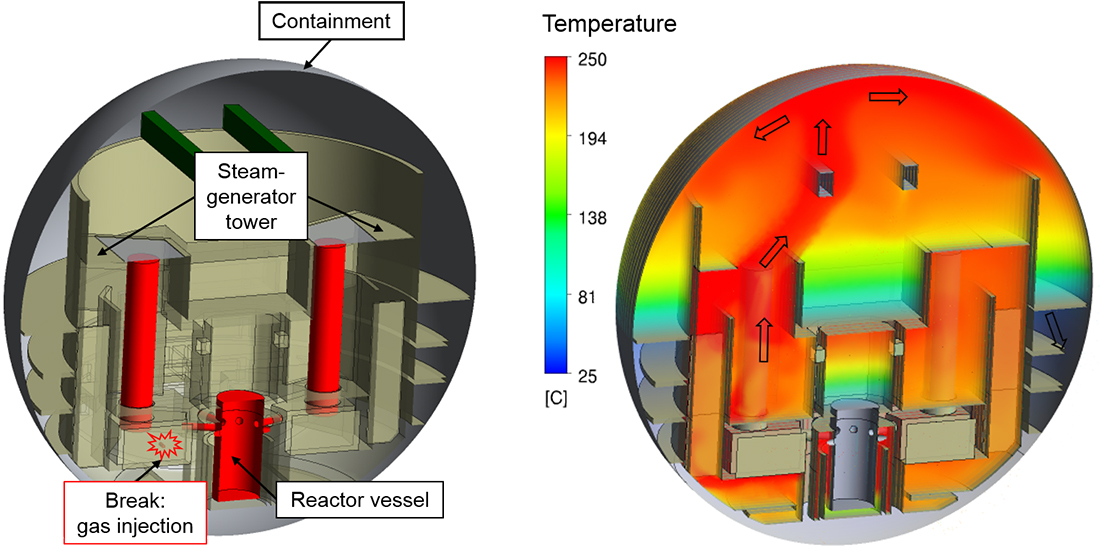ENVIRONMENT AND ENERGY
Simulation of Turbulent Flow With a CFD Method in a Power-Plant Containment
Principal Investigator:
Eckart Laurien
Affiliation:
Institute of Nuclear Technology and Energy Systems, University of Stuttgart (Germany)
Local Project ID:
TurboCon
HPC Platform used:
Hermit of HLRS
Date published:
Two-phase flows with water droplets greatly affect the thermal-hydraulic behaviour in the containment of a Pressurized Water Reactor (PWR). In order to predict the local thermal-hydraulic behaviour in a real containment in the case of a severe accident, scientists of the University of Stuttgart generated a three-dimensional geometry of a model containment based on a German PWR.
A postulated accident scenario in a Pressurized Water Reactor (PWR) is a leak in the primary circuit resulting in steam and/or hydrogen injection into the containment. Because of the influence of steam condensation on the gas mixing, turbulent flow and natural convection inside the containment, the condensation phenomena are of interest for the safety considerations. In order to predict the local thermal-hydraulic behaviour in a real containment during a severe accident, a three-dimensional geometry of a model containment was generated based on a German PWR including main rooms, free volumes and main metallic structures, see in Figure 1 (left). Its total mesh has about 10 million nodes, which requires a High Performance Computing (HPC) system. In close cooperation with ANSYS Germany GmbH, the Computational Fluid Dynamics (CFD) code ANSYS CFX is used for simulations in this project. Because the usage of a large amount of HPC license for ANSYS software is available at the High Performance Computing Center Stuttgart (HLRS), the simulations were performed on the former system CRAY XE6 (Hermit).
One simulated result is shown in Figure 1 (right). Initially the colder air is present in the model containment. During the severe accident, hot steam and hydrogen are released as a horizontal jet through a small break at the lower part of steam-generator tower into containment. The transient simulation was carried out using the wall condensation model and the Shear Stress Turbulent (SST) turbulence model, which is developed based on Reynolds-averaged Navier-Stokes (RANS) equations. As shown in Figure 1 (right), the hot flow travels upward as a plume driven by buoyancy. Then it moves towards the dome through one broken burst disk, which is opened in the case of overpressure. While the hot gas is consistently released into the containment, the temperature inside the containment is increased.

Figure 1: Containment geometry (left) and simulated temperature distribution at 2300 s after the accident (right).
Copyright: IKE, University of StuttgartIn the next step the spray system should be considered to reduce the containment temperature and pressure. The future simulations will be performed on the entire system CRAY XC40 (Hazel Hen) at HLRS
Acknowledgements:
This work was supported by the German Federal Ministry of Economic Affairs and Energy (BMWi) on the basis of a decision by the German Bundestag, with project number 1501414 and 1501493. The simulations were performed on CRAY XE6 (Hermit) at HLRS under the grant number TurboCon/12843.
Research Team and Scientific Contact:
Jing Zhang, Christian Kaltenbach, Abdennaceur Mansour, Eckart Laurien
Prof. Dr.-Ing. Eckart Laurien
Institute of Nuclear Technology and Energy Systems (IKE), University of Stuttgart
Pfaffenwaldring 31, D-70569 Stuttgart (Germany)
e-mail: eckart.laurien [at] ike.uni-stuttgart.de
http://www.ike.uni-stuttgart.de/